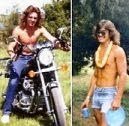
Two years before his demise,
George Armstrong Custer led the 1874 Yellowstone Expedition, occasionally pausing
for a photograph for posterity by William Illingworth of Saint Paul. With him are his "favorite scout," Bloody
Knife, kneeling on the left and pointing at the map held by the seated Custer. Private
John Burkman, assigned as an orderly to Custer, stands behind with scouts Goose
and, kneeling on the right, Little Sioux. Two staghounds, evidently bored with
the photo shoot, are napping near Custer.
The heavy-barreled rifle in
the foreground possibly is Custer's Remington .50-caliber sporting rifle he
carried with for hunting. You might note each of the Indians has a Model 1873 Colt
Single Action Army revolver in .45 caliber and with a seven and one-half inch
barrel. Those were the handguns carried into battle at the Little Bighorn River
145 years ago today. These handguns were state of the art for the era; the
Springfield Trapdoor Model 1873 rifles carried by Custer's men in .45-70
caliber were not, which is among the reasons the 7th had
a "bad day."
Tuck, Swift, Lady & Kaiser
On June 12, 1876, George
Armstrong Custer wrote a letter to his wife, Elizabeth (Libby), which included
these statements:
"Tuck regularly comes
when I am writing, and lays her head on the desk, rooting up my hand with her
long nose until I consent to stop and notice her. She and Swift, Lady and
Kaiser sleep in my tent."
Thirteen days later, Custer
lay dead on what has come to be called "Custer Hill" just above the
Little Bighorn River in Montana. The dogs -- Tuck, Swift, Lady and Kaiser,
presumably, were with Major Marcus Reno and Captain Frederick Benteen and surviving
troopers under their command on another nearby hilltop under the care of
Private John Burkman.
Reno and Benteen were in
charge of details separated by Custer from his immediate complement and were
not among the troopers who rode with George and killed to the last man.
Burkman was an orderly
assigned to the Custers with the 7th Cavalry Regiment. The
"general's" other dogs were with Libby, ostensibly safe and sound, at
Fort Abraham Lincoln seven miles south from Mandan, North Dakota, the location from
which Custer had set out.
It is not unusual for me to
take note of "Custer Day," as I refer to June 25, the anniversary of
the "scrap" at the Little Bighorn. Custer and "a couple of
hundred" troopers, scouts, contract employees and tag-alongs were killed
by a few hundred (or, maybe a few thousand, depending on whose figures you
accept) Lakota Sioux and Northern Cheyenne and Arapaho.
I have written posts at
length about elements of the event, but today decided to simply to run this
photograph and a couple of paragraphs. There is such a wealth of material about
Custer and the 7th -- much of it appearing in just the last
decade or so -- that it probably would be impossible to keep current of it.
Libby Custer, as was her
custom, had traveled with her husband the first day out on the expedition and
would have taken the dogs accompanying them back to Fort Abraham Lincoln except
for the fact some refused to leave George.
John Burkman is one of only
a few names associated with "Greasy Grass" I will mention today. The
battle of Greasy Grass is the name given to the encounter by the Plains
Indians. Burkman was born January 10, 1839, in Alleghany County,
Pennsylvania (or, maybe, Germany). On the morning of Sunday, June 25, 1876, he was ordered by
Custer to stay behind with Benteen and the pack train.
"Take good care of the
horses, Burkman. We may need them before morning," were the instructions
Custer gave to Burkman the night before the battle at
the Little Bighorn, according to the Billings Gazette.
Before setting out for the
Indian encampment later, Burkman said Custer gave orders for him to stay with
the pack train: "Stay with the pack train, Burkman, and take good care of
the horses, were his orders to me. And it was the first time he ever left me
behind in a fight. Those were his last words to me. And the next thing I knew
of Custer and those five companies, was the news of the massacre."
Much of the Burkman information
came from Glendolin Damon Wagner, a Billings writer whose books included one
called "Old Neutriment." It was published in 1934 and based on
information Burkman had told to I. D. "Bud" O'Donnell and who, in turn, had
provided it to Wagner. Take that with an extra long hmmmmmmm ....
Burkman survived the hilltop engagement between elements of the 7th under Reno and Benteen and the Indian forces. Burkman was discharged from the army for disability in May 1879. He lived for a while in the soldier's homes in Los Angeles and Washington, but left the last in April 1923. Burkman reportedly was found dead November 10, 1925, in a Billings boarding house with a smoking gun in one hand and a bag of candy in the other. His death was ruled a suicide.
If you are wondering about the
eventual fate of Tuck, Swift, Lady and Kaiser, so am I. Since Burkman was in
charge of Custer's dogs, they stayed behind with him and, almost certainly, were at
the hilltop wing-ding. There is no further mention of them that I have
encountered.





.jpg)











